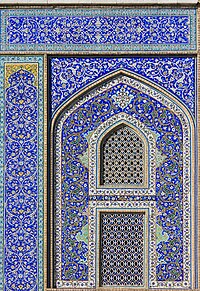Surau
This article needs additional citations for verification. (January 2025) |
| Surau | |
|---|---|
 Late 19th-century village surau: Surau Lubuk Bauk, in Padang Panjang, West Sumatra, Indonesia | |
| General information | |
| Status | Worship and religious teachings |
| Type | Religious building |
| Architectural style | Indonesian |
| Town or city | West Sumatra (originally)[1] |
| Country | Indonesia Malaysia |

A surau is an Islamic assembly building in some regions of Sumatra and the Malay Peninsula, used for worship and religious instruction. Generally smaller physical structures, their ritual functions are similar to those of a mosque, they admit men and women, and they are used more for religious instruction and festive prayers. Surau mostly depend on grassroots support and funding and can be compared to the Arab zawiya.[2] In the Minangkabau society of West Sumatra, Indonesia, they are built on high posts and maintain pre-Islamic traditions of a men's house.[3]
In contemporary usage, "surau" is often used to refer to either a small mosque or a designated room in a public building (such as a shopping mall, a university, or a rest stop along a highway) for men or women to perform salah.
Indonesia
[edit]This section needs additional citations for verification. (January 2025) |

Surau among the Minangkabau of West Sumatra date to pre-Islamic times, as men's communal accommodation. The first such surau is believed to have been built in the late 17th century, in the coastal town of Ulakan.
Smaller establishments are known as surau mangaji and mostly consist of a small room for 20 students and one teacher, who is usually also the imam and teaches Quranic recitation. Large surau, during the heyday of surau culture in the 18th century, accommodated up to 1,000 students and included up to 20 buildings.
The central figure of a surau was the tuanku shaikh, who oversaw a large number of teachers. The establishments were maintained by foundations (waqf) and funded through donations from parents. Minangkabau surau have similarities with the institution of the pesantren, which initially only occurred in Java.[2]
Many surau were simultaneously centers of Sufi orders. The surau of Ulakan served as a center of the Shattariyya order, which had been introduced by Burhanuddin Ulakan, a student of Abd al-Rauf al-Fansuri. Other orders, which had their own surau in Minangkabau, were the Naqshbandi and Qadiriyya. Some students visited various surau in succession and could be members of different orders.[4]
The early 19th century witnessed the surau system of Hāddschis in Mecca, which came in contact with the teachings of the Wahhabi. They and their followers, the so-called Padris, denounced the surau as centers of dissemination of un-Islamic teaching and practices, and they burned some of them during the so-called Padri War (1821–1837). Other events that heralded the demise of surau culture was the 1870 introduction of a new type of school, the so-called sekolah nagari, by the Dutch, and in 1900, the intellectual attacks of reformist Muslims who denounced surau as signs of backwardness and established secular schools.[5] Today, there are tentative attempts to revive surau culture within Minangkabau communities.[6]
Malaysia and Singapore
[edit]This section needs additional citations for verification. (January 2025) |

On the Malay Peninsula, the functional difference between a mosque and surau is not always clear. In rural areas, the surau was for centuries the center of Islamic worship and thus tantamount to a mosque. Surau continue to exist in contemporary urban areas of Malaysia and Singapore, with mosques being typically built by the state and surau depending on public initiatives. During the heyday of the Dakwah movement[clarification needed] in the 1970s and 1980s, surau in Malaysia were also centers of student life, with students spending several nights each month in surau to perform iʿtikāf.[7][8]
See also
[edit]- List of mosques in Indonesia
- Musallah, a similar structure in other Muslim countries
References
[edit]- ^ "Melacak Akar Sejarah Pendidikan Surau: Asal-Usul, Karakteristik, Materi dan Literatur Keagamaan" (PDF).
- ^ a b Azyumardi Azra, Islam in the Indonesian World: An Account of Institutional Formation. Bandung 2006, S. 63–69.
- ^ "Mengembalikan Peranan Surau di Minangkabau".
- ^ RA Core, The Origin of the Malay Surau. The Journal of the Malayan Branch of the Royal Asiatic Society, 29/1 (1956) 179–181.
- ^ Kerstin Steiner. Madrasah in Singapore: Tradition and Modernity in Religious Education. Intellectual Discourse, 19 (2011) 41–70.
- ^ "Archived copy". Archived from the original on 31 August 2018. Retrieved 31 July 2015.
{{cite web}}: CS1 maint: archived copy as title (link)[dead link] - ^ Sharifa Zaleha. Surau and Mosques in Malaysia. ISIM Newsletter 3, 1999
- ^ Zaleha, S. (24 September 1999). "Surau and Mosques in Malaysia". ISIM Newsletter. 3 (1): 9. hdl:1887/17311 – via scholarlypublications.universiteitleiden.nl.
Further reading
[edit]- Islam in the Indonesian World: An Account of Institutional Formation by Azyumardi Azra Mizan Pustaka, 2006


